In this place branding case study, learn about the development and implementation of a place and destination brand strategy for the area of central London, known as London Bridge, one of the oldest areas of the city, dating back at least two millennia.
The case study was written by Malcolm Allan, founder and Managing Director of Placematters (PM), a UK-based place brand strategy consultancy, and Donald Campbell, Place Marketing Manager of Team London Bridge, which manages the Business Improvement District for that area of central London.
Learn about:
- The commissioning of place brand strategy and destination audit;
- The community consultation;
- Creating the brand proposition;
- Implementing the proposition;
- Lessons of relevance for other similar city areas.
Part 1: Commissioning of place brand strategy and destination audit
About London Bridge
The London Bridge area (often thought of as the area around the south side of the current London Bridge over the River Thames and the adjacent major railway station) is one of the oldest settlements in the UK and possibly the oldest part of London, dating back over two millennia.
The area has strong associations with the Romans, with English cultural history (Chaucer, Marlowe, Shakespeare, Johnson, Dickens, Peyps) and the development of English global trade with the colonies (e.g. importation of tea, sugar, meat, cloth).
It is known for innovative commerce (e.g. railway engineering, food preservation and canning, clothing manufacture), the development of community health care and medicine (medieval hospices and latterly Guy’s Hospital), higher education (Kings College), and the visual arts (the Tate Modern and the Design Museum anchoring the western and eastern sides of the area).
London Bridge is also associated with modern global business and the media, as exemplified by the occupants of The Shard and the More London developments.
The graphic below shows the area that Team London Bridge BID is responsible on the south bank of the River Thames, between London Bridge and Tower Bridge.
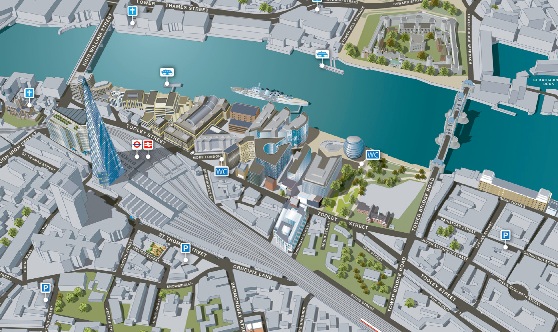
Commissioning the strategy
In May 2013, Team London Bridge (the Business Improvement District Team for this area of central London) awarded the contract for the development of a brand strategy and brand identity to Placematters (PM). This followed a presentation to the Board of the BID by PM in January 2013 on the benefits of place brand strategy which led to the BID publishing a competitive request for proposals.
The BID Team had concluded that, while the name London Bridge is world-famous, no one was clear as to what the area of London Bridge represents. Such an iconic name is an obvious asset to have and if defined and utilised correctly it could become of enormous commercial benefit to the area’s stakeholders.
The London Bridge community was at a stage where defining a sustainable place brand proposition and identity was both achievable and desirable. Potential place defining developments were either complete or underway and the business mix and property use will be consistent for the foreseeable future.
At the same time, rival areas were working hard to enhance their place brand and London Bridge needed to be competitive and have a distinctive offer and set of experiences.
In response to the RFP, PM submitted a proposal covering:
- The formation of a Steering Group of representatives of local residents, workers, businesses, land owners and developers, operators of tourist attractions and representatives of local government, to guide the development of the brand strategy.
- An audit of the offer and experience of the area to assess what it offers and to whom.
- Consultation with local residents, workers, businesses, organisations and visitors to assess how the area works, what is valued and what needs improving.
- The development of a brand proposition to guide future development of the area and the marketing of its evolving offer to target market audiences.
- The design of a new brand identity for the area for use in promoting the agreed brand proposition.
- The development of an initial “Experience Masterplan” to guide the creation of improvements to the current offer and additions to expand it.
- Advice on marketing the agreed brand proposition and the use of the new brand identity.
Work commenced in June 2013 and was completed in February 2014.
The formation of a steering group
On the advice of PM, the BID Team invited a cross section of the key stakeholders of the area to join a group to steer the development of the brand strategy. They included representatives of local corporate business, small firms, the food and beverage sector, property developers, property managers, tourist attractions, the local authority and Network Rail, then undertaking (as now) a major rebuilding and expansion of London Bridge Station.
The audit of the offer and experience of the area
Two key elements of work were undertaken at the commencement of the project to better understand the area and how it worked as a place and destination.
The first was to identify and categorise the existing offers and experiences of the area to guide the preparation of a brand proposition.
The second was consultation with local residents, workers (including commuters) and businesses to assess their perceptions of the area – spatially (the area they thought of as London Bridge), the offer of the area, their experience of being there, what worked and what didn’t, and their ideas for improving the way the place works, for new facilities and services.
The place audit
The audit of the current offer of the area identified that it was a “fluid” area in people’s perceptions and this seemed to depend on what they use the area for, where they go to in the area on a regular basis, how far they have explored it and where they live or work. And, by any yardstick, the area has a critical mass of important and interesting attractions and assets that pull in a national and international audience of investors, employers, workers, residents and visitors.
These included people who lived in the area and worked elsewhere, people who lived and worked in the area, people who worked in the area and lived elsewhere (largely rail commuters), people who travelled through the area to work elsewhere, mainly in The City on the north bank of the River Thames, owners of small businesses, major corporate employers, tourists from around the world, visitors to the area’s arts and cultural attractions.
The London Bridge area is clearly on the international “tourist map” of London with tens of thousands of people annually visiting the major attractions in and around the area, principally the Tower of London and the Tate Modern, which draw people into and through the area.
It is however the array of tourist attractions in such a relatively small area that gives the place a critical mass of attraction power: the Thames riverside walkway, HMS Belfast, Tower Bridge, the George Inn, Guys Hospital Operating Theatre Museum and Herb Garrett, the London Bridge Experience, the Golden Hinde, the View from the Shard, the proposed New Science Gallery at Kings College, the Tate Modern, the Design Museum, the Fashion and Textile Museum, the White Cube Gallery, the Globe Theatre, the Greenwood Theatre, the Southwark Playhouse, the Architecture Foundation and Southwark Cathedral.
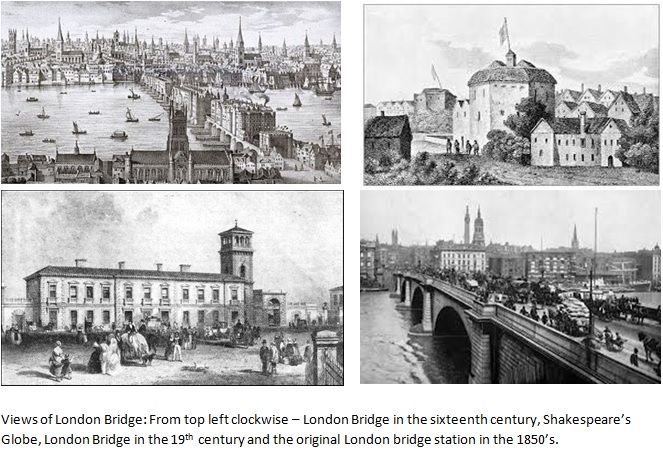
We identified that in recent years that the area had become increasingly attractive as a location for large corporate businesses and an array of SME’s locating in the area to service them and others in the City. The business space offer of the area had clearly markedly improved over the previous ten years and there was now a range of types of accommodation at a variety of price points.
Supply has been significantly boosted by the offer of The Shard, which had attracted a number of global operators such as Newscorp, which is strengthening international perception of the area as a desirable business location, already increasing demand for business support services and services for the expanding workforce now beginning to locate in the modernised railway arches and the refurbished buildings around this major development.
As a result, provision for small and medium sized businesses in the area was improving bit by bit over time and there was a growing interest in renewing older and outdated buildings, albeit being undertaken in a piecemeal fashion, as is often the case in areas undergoing transition.
As a result, the employment offer of the area was and remains significant with a range of job opportunities being available in the corporate and independent sectors with a wide variety of job opportunities. The area is very accessible for commuters through the transport hub at London Bridge Station and is likely to remain an employment magnet for the foreseeable future.
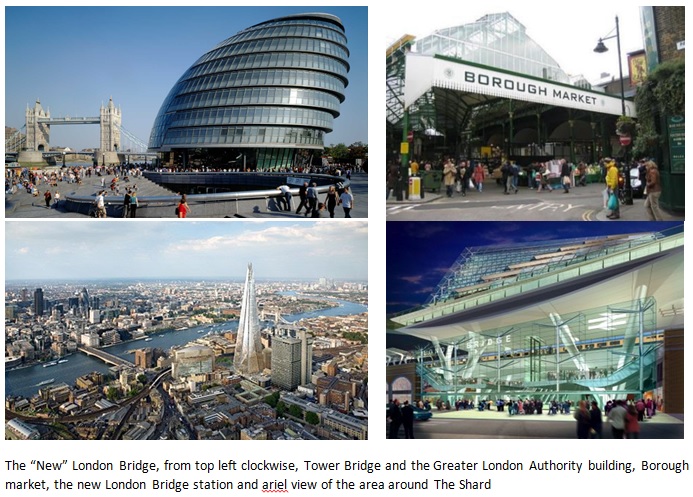
Given the significant and continuing growth of employment in the area, we identified that it was poorly served by retail and food and beverage outlets. We had expected an area that had so many employees in corporate companies to have a far better range, type and quality of provision than currently exists in the area.
However, an exception to this is the fresh food to go offer at Borough Market, which is probably one of the best known in London and which has a recognised profile internationally, recently complemented by the establishment of a number of clearly successful permanent restaurants in its offer.
We concluded that for a relatively small place, the wider London Bridge area (see the map above) had a significant critical mass of attractions, assets and experiences, one of the most significant in central London. This, taken with the history of the area, makes it a must visit place on many tourists itineraries.
And, given the existence of a major and improving transport hub at London Bridge Station, which makes the area very accessible to commuters, and the significant growth in quality commercial floor space in the area in recent years, it is becoming an increasingly attractive and favoured area for business and employment.
The history of the area, as a settlement, as a place of trade, commerce and governance, its literary and theatrical associations, its role in the development of central London, is significant but was underplayed in the current offer of the area, and we concluded that there was a real opportunity for it to be given greater emphasis through a new brand proposition.
Place characteristics
From the audit of the area, we identified that it had a number of dominant characteristics which strongly typify the area and give it a strong identity as summarised in the graphic below:
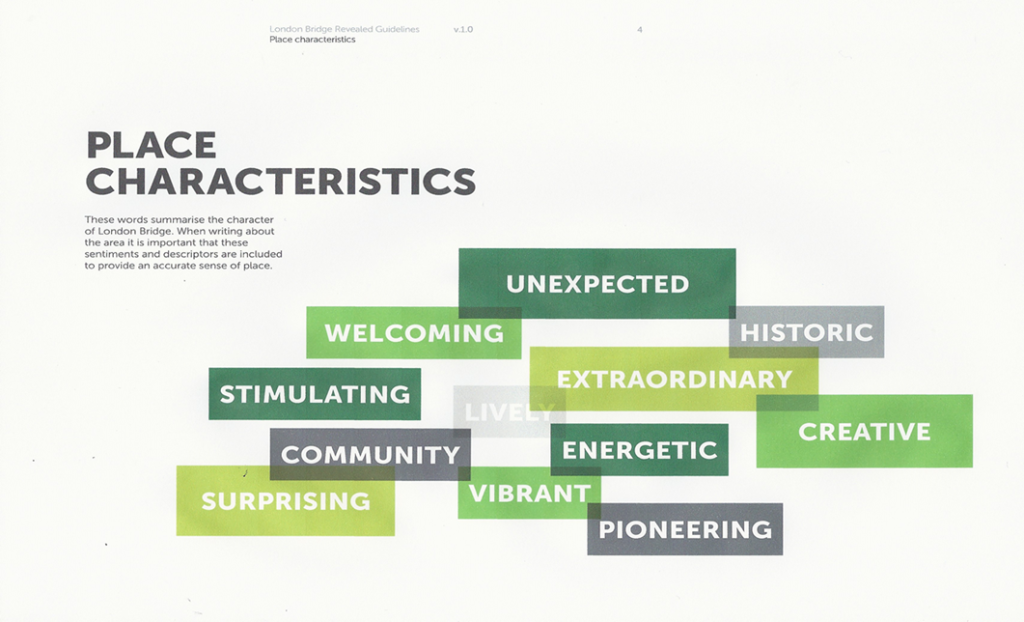
Unexpected and Surprising –The area has a strong range of powerful value propositions and a range of distinctive quarters within it that are, as yet, largely undiscovered by many people who travel through it or who work there and people who do not yet have a reason to be there. There was so much about the area to be revealed and experienced!
Constantly Changing and Evolving – The area has changed over history and continues to do so as it adapts to the changing demands of commerce, enterprise, residents and visitors.
Extraordinary – The area has an extraordinary range and concentration of different types of businesses, services, facilities, heritage sites, attractors, environments and experiences, and stories to be told about its past and current development, more so than most other central areas of London.
Welcoming – The area has a justified and valuable historic reputation for being very welcoming of visitors and new businesses and residents attracted to it.
Pioneering – The area is known for being pioneering in its offer of business activities, services and products. It has been known as “The Larder of London”, a place where raw commodities were imported and where they were turned into a range of foodstuffs, and where new foods and fruit from the world arrived and were in turn exported to the rest of London and the rest of the country. It was also the location of a number of innovative engineering companies involved in the great railway boom of the 19th century, whose products were used to bring the railway lines into London Bridge and in the operation of the new suburban train services.
Vibrant and Stimulating – The area has been characterised as being busy, or vibrant in the modern sense of the word, for a number of centuries, being a place of many different types of businesses, many types of activities, with lots happening. It remains an energetic commercial area attracting a range of types and sizes of business.
This characteristic of the business life of the area is also typical of its appeal as a place to live and work. Put simply, there is a lot to do in the area by way of local festivals, events and programmes. It is a very stimulating place to experience. And there is a growing and improving range of food and beverage establishments, many in independent ownership, catering for both residents and workers as well as tourists visiting the area; possibly the most varied concentration in central London.
Making and Creating – The area has been a place where many types of products were designed, created, made and manufactured for hundreds of years and it retains this powerful characteristic in sectors such as the arts, craft products, food products, fashion and clothing.
Connecting – For hundreds of years the area has functioned as a place that connected people and business to central London, the rest of London, the rest of the UK and to the Empire for business, trade and commerce. And it retains this characteristic today.
Strong Sense of Community – Despite the recent large scale of commercial development in the area, it has managed to retain a strong sense of community, with many long-term residents and attracting many people who prefer living in busy urban areas in city centres with access to many different kinds of jobs and lots of things to see and do.
Living History – The area is very strongly linked with the development of London, from Roman times through to the present and has strong historical associations with arts and culture, with artists and writers, with designers and manufacturers of products, with the development of key sectors of London’s economy. The area is not a museum. It’s very much alive. In its historical development, it has retained a number of buildings that exemplify and illustrate its evolution, often adapting them for new or modern purposes. And its urban environment reflects that development and evolution and the adaptability of the area.
Initial Conclusion and the Key Challenge
Overall, the area had a lot to offer to a large and mixed audience and therein lay the substantive brand development challenge – what to build the brand offer upon and for which target audiences, or to put it another way, how to play an extremely good hand with the existing cards?
Part 2: Community consultation
The community consultation process was largely carried out online through a specially designed set of web pages that were incorporated into the Team London Bridge web site. This element of the project was designed and managed by Shilpa Bhatnagar of Ideado Consulting, and the following section of this post draws on her report on the consultations.
In our experience, people’s perceptions about place are formed by their experience of them over time. In order to create a brand proposition for a place, we believe that it is critical to understand how people – those who live, work, do business in a place or who visit the place – perceive it. It’s important to understand the characteristics they think are important to the place and how they see or want the offer of the place to change over time.
While individual people might perceive the place differently, based on their personal use characteristics and experience of the place, the essence of an audit of how people use a place and see it lies in understanding the story emerging from these many views and identifying common and important threads – to help create a brand proposition that tells a compelling story of the offer and experience of the place.
The consultation process aimed to seek answers to the following overarching questions:
- How did people perceive the London Bridge Area?
- What, in their reading, are its key characteristics, attractors, positives and negatives?
- What is the spatial and cognitive perception of London Bridge area in people’s views?
- What area, and what key landmarks did they immediately think of when they thought of London Bridge?
- How did people rate its current set of attractors, assets, services and amenities? What is its current value to them? How aware were they of its current offer and how would they like to see it change?
- What did they envision as the future of London Bridge area?
Four different channels of recording input from respondents were devised with the aim of reaching as many respondents as possible, and allowing for a range of means to capture their views based on their convenience and willingness to participate. These were:
- A quantitative and qualitative online survey (taking 5-10 minutes)
- A free comments box – to allow respondents to add further comment on any issues they feel were not covered by the online survey (with a 500 word allowance)
- An option for people to sign up for personal interviews (either face to face or on the telephone) with a member of the PM team – which ranged from 30 minutes to 2 hours.
- An additional regular survey conducted by Team London Bridge. Key questions from the online survey for this exercise were appended to a regular survey that is emailed to a large number of Team London Bridge business levy papers to attract additional input.
Consultation responses and findings
The consultation was conducted over a period of four weeks starting 7th June 2013 and ending on 5th July 2013. During this period, all channels were open and were being operated simultaneously by the consultation team, in order to capture the maximum response possible. The split of respondents across channels achieved was:
- Business Owners / Businesses: 6%, Employees / Workers: 55%
- Local Residents: 34%
- Business Visitors: 5%
- Other Visitors (Tourism / Social / Cultural): 8%
Where is London Bridge?
At the outset, it was critical to know how people perceived the London Bridge area spatially – where it’s perceived boundaries are and which major landmarks they associate with the place. The three landmarks or places that most respondents identified as inseparable or most relevant to the London Bridge area were London Bridge Station (92.5%), Borough Market (73%), The Shard (72%), and London Bridge itself (64.1%).
Most respondent’s spatial perception of the area completely disregarded the BID boundaries and tended to include a much wider geographical area than how the BID delineates its area.
An interesting comment from a personal interview suggested that The Shard has effectively expanded the perceived boundaries of the area – it is now visible from a very large distance away and the sense of being in or in close proximity to it now starts from farther away than it used to in the past. In this sense, for better or for worse, The Shard acts like a new “beacon” for the area.
The map shown below indicates that for many respondents the area they thought of as London Bridge was much wider than the immediate area around the station at London Bridge and at the south end of the bridge (as shown on the previous map graphic). Potentially the area could extend to Blackfriars Bridge in the west and the western edge of Rotherhithe in the east, taking in some of the Bankside BID area to the west of Borough Market, the Tate Modern and the Globe Theatre.
The scale of the experiential area of London Bridge was perhaps surprising to even those who have been involved locally for many years, providing a great example of how assumptions about a place brand could undermine its credibility if the research and consultation process isn’t carried out properly.
Most respondents saw London Bridge as primarily a business and commercial zone and a major transport hub. This was followed by a secondary characterisation as an area for tourism, and much less so as an area for leisure and recreation. Most respondents did not see the area as place to live and, interestingly, a majority of residents personally interviewed expressed the view that it was declining as a place to live.
Almost half of all respondents felt the need for more cafes, pubs, bars and restaurants, while the other half thought that the area had more than enough of these at the moment. A number of personal interviews suggested the need for a better range, diversity and quality of restaurants, cafes, pubs and bars, rather than more of them.
And, while a significant number of respondents (45%) vote for more high street retail and F&B brands and chains in the area, the percentage of respondents who wanted to see more independent retailers in the area was significantly higher (71%). Most people personally interviewed felt that independent retailers would better suit the eclectic nature of the area as well as its population. We concluded that a balance might need to be struck between high quality independents and a smaller number of high street brands and chains to cater to the needs of the growing number of people being employed in the area.
Nearly 53% of respondents thought that the area could do with more and better quality business space for small businesses and sole traders, with flexible and temporary serviced space for business.
While London Bridge is and has always been a predominantly commercial area, even with the large number of our respondents who work in the area, the overwhelming opinion seemed to be that London Bridge had reached its commercial capacity at the time of the consultation.
All qualitative comments indicated the need for better quality space rather than more space, which suggested that the way forward for commercial development in the area might be sensitive redevelopment and refurbishment of existing commercial space, rather than adding more new space for business in addition to what exists. There certainly was a demand for better quality space for small businesses and more innovative models for providing flexible and modular business systems, rather than single use large floor plates.
There was an almost unanimous demand for improvement in the public realm in the area. A number of respondents cited street clutter, confusion, chaos, poor pedestrian and cycling experience, traffic congestion, pollution and widely differing quality of public realm as problematic.
Safety and security measures was the only characteristic of the area that was rated acceptable overall by a majority of respondents, in our view largely because of the work of the BID. A number of people interviewed feel that ‘softer’ measures like encouraging active use and vigilance in lonely areas etc., should be employed, rather than the more traditional hard-core measures of increased policing, CCTV’s and the like.
Many respondents wanted to see innovative uses in the arches and tunnels along the railway, which arguably would go a long way in making these zones feel safer.
Conclusions on consultation
As a result of the consultation, we reached a number of conclusions on what were, in essence, directional guidelines for the development of a brand proposition from the people who live, work and play in this area – and critical insights for a future vision for the evolution and development of the area.
Defining the boundaries
Identifying a clear boundary of what constitutes the London Bridge area would be one of the main challenges of this place brand development process. The map above is a broad reading of what a majority of the 519 respondents considered to be the London Bridge area, but this would only serve as a starting guideline for the brand proposition. While the BID’s own boundaries were never set as a constraint for the project, the influence of any place brand proposition for the BID would impact a much wider area and benefit a much greater community within and beyond its boundaries.
Recognising the history of the area
The London Bridge place brand needed to invoke the area’s historical and cultural heritage and assets along with a view to its re-emergence as an important area of business and commerce.
London Bridge has always been one of London’s pre-eminent areas of commerce and business and, while this has been its primary role through its very long history, in the contemporary context it is equally an area of great historical and cultural interest, given its links back to Roman times, and its significance to London through the ages.
In recent times, these two primary characteristics seemed to be divergent in terms of perceptions of the area and what it has to offer. A major challenge for the development of the brand proposition was how to reconcile these different perceptions.
A place of many places
The brand proposition would need to take into account the essential variety of the character of London Bridge. It is a collection of different types of area, a series of sub – brands almost, with sometimes nebulous boundaries, but with a very strong impact on its identity, which would be the second most important challenge that the brand proposition would have to address – bringing the patchwork of different types of areas into a single proposition without diminishing their individual value and attractiveness. If anything, the challenge for the place brand proposition was to give a ‘leg-up’ to all of these while creating an overall identity for the area that related equally to all of its parts.
Building on London Bridge’s uniqueness
Related to the previous point, the London Bridge area is quite unlike any other prominent city centre area in London. A large number of respondents felt that this uniqueness was its USP and, in their perception, the place was at the risk of losing this unique quality.
The overwhelming demand for independent, quirky retailers, rather than the stock chain brands of the high street, was a direct manifestation of this concern. It would be crucial for the brand proposition to build on and protect this character, especially at the stage of translating the proposition and the new place identity into discrete projects on the ground at a later stage.
Celebrating the bridge and the river
Almost all respondents felt that the river was the area’s biggest asset, yet a sizeable number felt that it was not celebrated enough in the area. Even more than the river, the bridge, London Bridge, that lends its name to the entire area, seemed to be only a place of transit, and was not celebrated as frontage and heritage in its own right.
When asked about associating major landmarks in the area to the name, London Bridge stood only at the fourth place, with other points of reference and landmarks far overshadowing it. Indeed, in popular perception, Tower Bridge was associated far more with the area than London Bridge, and many tourists mistook it for London Bridge.
Quality development as opposed to quantity
From the consultations, it was clear that while there was a clear demand for certain amenities – better convenience shopping, independent retailers, small and flexible business space, public realm initiatives – most people would like the emphasis of the brand proposition to be on the right mix of these, rather than a blanket provision to increase numbers.
For an area as unique and eclectic as London Bridge, this was an important thing to keep in mind for the future of the area – and especially while designing the Experience Masterplan for the place.
Part 3: Developing the brand proposition
In place and destination branding terms, we think of the brand proposition as being the description of what’s on offer in an area – for example facilities, services, infrastructure, events and programmes, and the experience on offer in the area – for example, ease of access to the offer and the way you are treated when accessing it.
A brand proposition is the promise that a brand makes and it is critical that brand’s promise is easy to understand, engaging, unique, relevant (to the target audience), and consistent across its offer; and it should address its audience’s current needs and wants and their future aspirations.
And a good brand proposition should be able to connect with its audience on an emotional level, as well as on a practical tangible benefit or problem solving level – a strong emotional connection can create valuable brand equity, e.g. people and business feeling good about being in the place or when visiting the place.
The brand building process
Following the completion of the place audit and the community consultation, the PM team assessed the assets of the area – attractions, facilities and services, and its attributes – the things it is good at, in order to identify potential building blocks for use in constructing a brand proposition.
The diagram below illustrates the brand proposition development process agreed with the BID Team, which consisted of four stages:
- The identification of potential building blocks derived from the destination audit and known plans.
- The construction of alternative brand scenarios.
- The selection and development of a preferred brand scenario.
- The construction of a brand proposition and value offers for target markets.

The building blocks
The team identified twelve potential building blocks, as summarised below.
The river
The River Thames was recognised as being central to the attractiveness of the area, to its history and to its identity. It will be a building block of most – if not all – of the potential brand scenarios.
A place to visit – the tourism, culture, heritage and history offer
The wider area offered an array of attractions for visitors to London and to the area, and this offer was worthy of consideration as a core brand scenario element.
A place to conduct business
The wider area was recognised as a place that had already become established as a place to run a business with a range of types and sizes of business space for occupation, ranging from the modern Grade A office floorspace at More London and The Shard, to converted premises in the hinterland south of the railway viaduct and older unmodernised space that offered a toe-hold in the area for star-ups. The area’s role as a business location was considered to be a core brand scenario element.
A place for jobs – the employment offer
Clearly related to the role of the area as a location for business was its offer of a wide range and type of employment opportunities for different people with different skill sets and experiences. The area’s role as a provider of employment opportunities was similarly considered as a core brand scenario.
A place to eat, drink and entertain – the F&B, entertainment, leisure and recreation offer
And, related to the area’s role as a place of business and employment, was its growing role as a place to socialise in, to entertain in, to spend evenings and weekends in, largely created by the recent expansion in its food and beverage offer in response to employment growth – a mix of national brands and independent operators, the latter often being situated in areas with an independent retail offer, such as Bermondsey Street, which had increased the attractiveness of the area and its offer.
A place to shop – the retail offer
While we recognised that the wider area was not currently regarded as a shopping destination, it clearly had potential to improve its offer, not as a pure retail destination per-se, but as an offer that supported other more core brand elements like being a place to work.
A place to attend events
And while we also recognised that the area is not a venue destination on the scale of the offer of the Southbank near Waterloo, the area had an increasing and popular programme of events throughout the year, attracting an audience from across the south east of England and, for some events, such as shows at the White Cube Gallery and exhibitions at the Fashion and Textile Museum, an international audience. As with the retail offer, we did not see this as a core brand scenario, rather as a support to the core brand scenarios.
A place to hang out – the Riverside public realm
While many tourists – domestic and international – are drawn to the area by the primary tourist attractions, such as HMS Belfast, the Tate Modern, the Globe Theatre and Tower Bridge, they are also attracted by the opportunity to access the Thames riverside and to look at the views that the walkway provides. This is an important supporting building block that supports the core brand scenarios we identified.
A place to develop property
To some it may sound strange to include the opportunity to develop property as a brand building block. Central city areas like this are dynamic, ever changing, responding to changes in business and consumer market needs, responding to opportunities as they arise and their stock of buildings changes to meet changing needs of occupiers, be they large corporate companies, small independents, tourist attractions, cultural centres or residents of the area.
For these reasons, we believed that a potential building block for a brand strategy for the area is the offer it provides for the owners of buildings and developers to adapt, improve, renovate or redevelop sites and buildings, especially those no longer fit for purpose or occupation for their original or last uses.
A place to live – the residential offer
Despite the growth in the area becoming a place to locate a business, to attract and employ a workforce and provide it with jobs, the area remained attractive to some people as a place to live and as a place to live and work. We believed that this should be considered as a core brand scenario for the area, albeit one that may be a less powerful draw of people and spend to the area than the other four potential scenarios.
A place to learn
In various ways over the centuries, in the religious establishments of the area and in its medical establishments, the area has had a role and function as a place of learning. In recent times in the medical and health sectors, this role has grown with the modernisation and growth of Guy’s and St Thomas’s teaching hospitals and the expansion of Kings College University provision in the area. For these reasons, we believed that a potential supporting building block of a brand scenario is the area’s role as a place to learn.
A transport hub – a place to access the local and Central London offer
At the core of the area, London Bridge station is one of central London’s major transport hubs and enables access to the area and the wider offer of central London from the South of England. However, important as this is we did not believe that this offer was a core brand scenario for the promotion and development of the area; rather we thought of it as an “enabling” building block for the core scenarios.
The scenarios
As a result of our analysis of the building blocks available, we identified five potential scenarios on which to base a brand proposition:
- A place of business
- A place of employment
- A place to invest in development
- A historic and cultural place to visit
- A place to live
Each scenario was composed of a core element – the essential offer of the brand and a small number of lead elements – blocks that help to define the offer. These are then complemented by a number of supporting elements, building blocks that support and complement the lead elements of the brand offer.
The graphic below illustrates the Place of Business scenario.
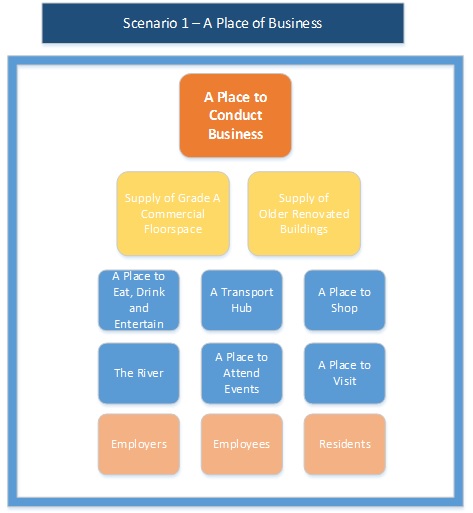
The rationale for this scenario is that the area is a good place for employers to conduct business. The lead building blocks are that the area has a good supply of Grade A commercial floorspace and a good supply of older converted or renovated buildings.
Complementing this are other offers of the area that will appeal to employers and employees alike, namely the range of places to eat and drink, the station as a transport hub, the (to be improved) retail offer, a place with a good events programme, a place of history and heritage that it’s nice to work in, a place of cultural facilities and attractions, and having the asset of the river. It’s an offer that is aimed at employers, their workforce, potential employees and local residents who want to work on the area.
The role of the steering group
These five scenarios were shared with the members of the steering group who individually responded to the team with their views on which scenario, or combinations of scenarios, should drive the brand proposition.
These individual responses were then shared at a workshop for the steering group, which identified a preferred scenario, actually a hybrid of several scenarios, for more detailed development.
The agreed place brand proposition
While there were differences of view on what combinations of scenarios might best fit the steering group’s vision on how the area should develop in the future, there was significant agreement that it would be primarily known a place of business and the brand proposition would be driven by this view.
The graphic below summarises the proposition that was constructed in the discussion by the steering group and their subsequent working through of its content. The members felt that this was a scenario that played to the current strengths of the area, its heritage as an innovative place of commerce and its developing role as a place of innovative commerce, enterprise and creativity.
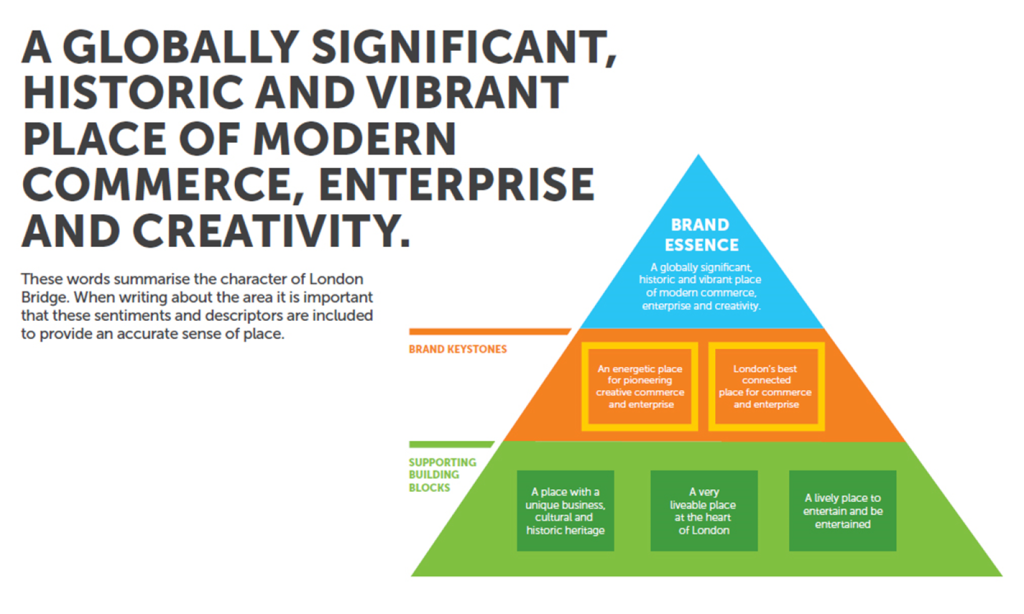
Brand Essence
The essence of the brand proposition is that this is a globally significant, historic and vibrant place of modern commerce, enterprise and creativity.
Brand keystones
The two keystones are:
- An energetic place for pioneering creative commerce and enterprise – significant and proven attributes of a place with a significant heritage of a strong global business and trade perspective, a heritage that is again evident in the location in the area of global commerce HQ’s and major branches of businesses that operate internationally.
- London’s best connected place for commerce and enterprise – the area has always been well connected and a place of interchange through the six or more bridges across the Thames that previously existed in and around the current location of London Bridge; through its closeness to the former Pool of London and its docks, particularly in Rotherhithe; through the accessibility afforded by the coming of the railways into this part of London in the mid-19th century and the later development of underground lines to and through the area to south London and, latterly, to the Docklands and East London; all of which strengthened the area’s position as a place of business, commerce and trade. Now, with the modernisation and expansion of London Bridge Station and its associated scope to accommodate a new retail and food and beverage offer, the attractiveness of the area as a place of connection, as a place to operate a business, as a place to find a job and as a vibrant place to live in central London, is being increased and it is still one of the best connected locations in central London.
Supporting building blocks
- A place with a unique business, cultural and historic heritage – the area has played a central, significant and important role in the history and development of London and is continuing to do so with the area developing as London’s newest and most modern location for corporate and global commerce, creative industries and independent retailing.
- A very liveable place at the heart of London – the area has always been a lively place to live with a lot going on and will remain so and, as its connectivity is improved and as its attractiveness to business improves, it will become more attractive as a place to live and work and access the many offers, facilities and services of the area and the rest of central London.
- A lively place to entertain and be entertained – in the Elizabethan era the area played the role of being an energetic place, a place of liberty (from the rules and regulations of the City) and entertainments (the pleasure gardens). More recently, as the area has developed as a corporate business location, it has seen a large number of cafes, pubs, and restaurants open in and around the station, Borough Market and along Tooley Street and Bermondsey Street, provision that also serves residents and visitors to the area interested in learning more about its unique and substantial heritage and history.
The core markets for the proposition
The core markets for the proposition are businesses, public organisations (LB Southwark, the Greater London Authority and the Mayor’s office in particular) and their employees. It includes existing businesses and businesses who are looking for a central city location in London – be they large corporates or small to medium sized independents, entrepreneurs and start-ups.
And it includes employees who currently work for businesses in the London Bridge area, people who would like to work in the area, and people who would like to live and work in the area.
The secondary markets
The secondary markets include:
- People who commute through the area to work in central London or who commute out of the centre to work in the inner city or the suburbs through the London Bridge transport hub, who might be interested in accessing the areas improving leisure and entertainment, food and beverage and evening economy offer.
- Developers and owners of property, who are interested in developing it or renovating it for business, residential or mixed-use occupation.
-
- Residents of the rest of London and South East England and visitors from abroad attracted to the area by its history, its business and industrial heritage and its cultural heritage.
Part 4: The initial implementation of the brand strategy
About three months into the project proper, the key stakeholders in the Steering Group had, under the guidance of the PM consultancy team, arrived at a Brand Proposition that provided a structure that could now be developed into deliverable projects and offers.
The research showed that the offer and experience of the area was and is regarded as unexpected and surprising; that it’s constantly evolving and seen as extraordinary, pioneering, welcoming, and vibrant. It is seen as an area that encourages creativity, aids connectivity and has a strong sense of community.
Making this Proposition tangible, and both easily recognised and understood, required that this new wealth of information be consolidated into a simple form. We needed a Place Brand Identity that effectively reflected these many characteristics and fantastic assets in order to address the finding that many were often lesser known, misunderstood, or underutilised.
After many hours of deliberation the Steering Group decided upon London Bridge Revealed as its brand campaign name. In its final design, it perfectly encapsulates how the consultees wanted to see the modern identity and aspirations of the area brought to life and celebrated.
Visual identity development
The development of a visual identity was more subjective and emotive than the development of the brand proposition. While the project was never about simply inventing a new logo we recognised that the many projects, we hoped the proposition would help guide and stimulate would benefit from a unifying look that would help convey the proposition effectively.
Finding a consensus on a brand identity in a group of stakeholders from very different backgrounds was a challenging task. Many high quality options were considered before the eventual fonts, colours and graphics were agreed upon.
The result is simple and adaptable. Structurally it represents the historic layers of the area overlapping, with the main blocks reminiscent of the bridges and viaducts that connect the area and a font that is modern and considered. Importantly, it works well when positioned next to other brands, either the primary project brand or as one of many partner logos.
A set of accompanying guidelines and principles was developed to help partners use the London Bridge Revealed visual identity based on a patchwork arrangement of ‘textures’ taken from the area.
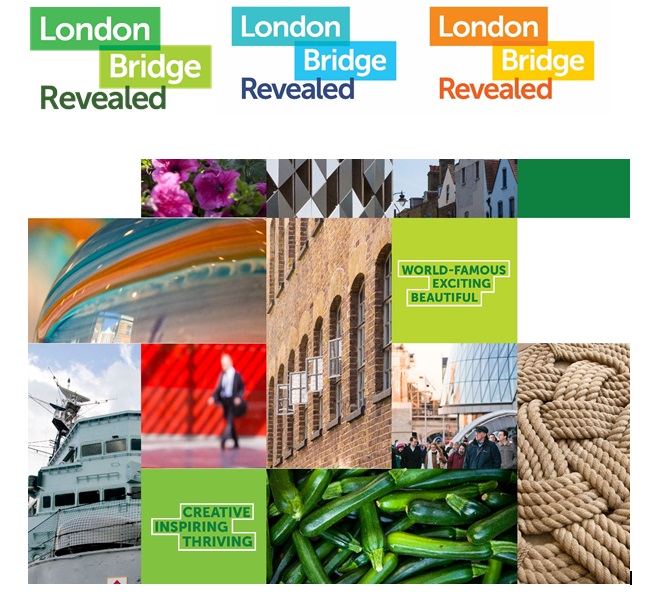
Brand management structure
As is the case with brands for fast moving consumer goods, place brand propositions need active, committed and ongoing management. Without committed management, place brands will wither and die.
A management committee is good in theory, but in practical terms it could stifle the proactive stance that a place brand must adopt. Therefore, to expedite the early implementation of the place brand, Team London Bridge assumed overall management of the brand within its existing structures. With an existing mandate to represent and promote the area, the organisation was best placed to deliver and develop projects.
The BID’s Place Marketing Manager took overall responsibility for London Bridge Revealed with support from the Team London Bridge Board and London Bridge Marketing Group. The Board is formally constituted and provides an infrastructure that can implement initiatives at a variety of levels within local organisations, while the Marketing Group can help identify new projects and offer guidance and insights to help gain audience recognition.
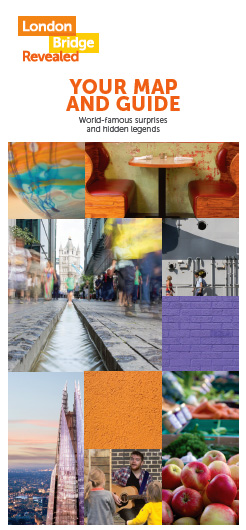 Identifying short-term projects
Identifying short-term projects
Following the significant engagement during the consultation work, it was important not to lose momentum in the delivery of the brand. The identification of some initial quick win projects allowed us to get London Bridge Revealed into the public domain in the short term. To be true to the Brand Proposition, we looked at potential projects and asked:
- Is it innovative?
- It is surprising?
- Does it aid discovery and exploration?
- Does it follow, or does it lead?
- Does it ‘welcome’ people?
If a project profile fitted any of these criteria, it was adjudged to be a good vehicle to announce London Bridge Revealed on the local stage. Some of the identified projects were:
- A printed map & area guide
- Capital project hoardings
- Local loyalty cards
- A destination website
- A tourist board film
- Visitor information and welcome service
- Totally Thames (sponsorship of local festival)
- London Bridge Live Arts (production of local arts festival)
- Guided walks and tours
- Signage on green infrastructure projects
- Dual branding on stakeholder newsletters
All of the above were supported by the London Bridge Revealed brand and delivered within the first six-12 months of the brand’s lifespan. Aligning the brand with these projects gave it credibility and endorsed it with tangible, practical offers and values. The management structure and independent apolitical nature of the BID allows new value propositions to be identified quickly and without prejudice.
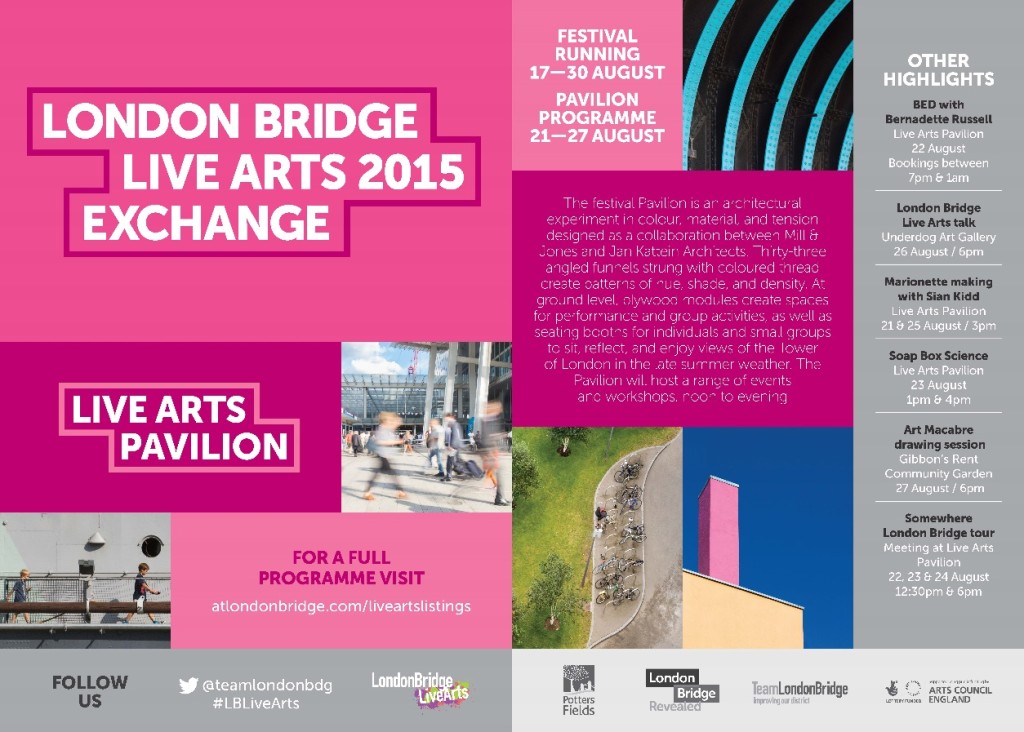
Medium and long-term projects
We have now moved into a more interesting phase of brand delivery. With the initial glamour to get London Bridge Revealed out into the public domain over, we could concentrate on integrating the brand proposition into projects as we build them from the ground up.
Establishing these projects requires more of a diplomatic, ambassadorial function of the brand management role, reinforcing the credentials of the brand and ensuring all project partners and stakeholders support and completely buy into its philosophy.
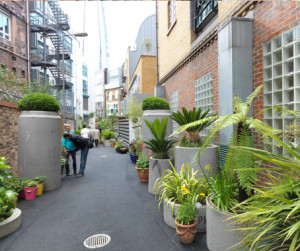 Some of the projects currently in development are:
Some of the projects currently in development are:
- IBeacons trail (new pioneering tech leading exploration)
- Permanent signage
- Lamppost banners
- Ambassadorial training
- The London Bridge Plan (a planning guidance document)
- Public realm improvements – shared space initiatives
- Team London Bridge Business Plan – services 2016-21
An annual communications plan has been developed around these short, medium and long term projects, utilising existing marketing channels and newly identified ones.
Assessing brand impact
In our view, it is important that brand management teams know what impact the delivery and communication of their brand offer is having. Without this knowledge, place brand managers cannot judge if the brand is resonating with its desired audience, if the chosen value offers are appropriate and the development of the brand is in line with the initial consultation and brand building blocks.
For the key London Bridge audiences of local employees, business owners and residents, the brand impact is being monitored via a bi-annual user panel survey that also monitors other areas of the BID’s service delivery. This usually gets around 300 responses via an online survey.
In addition, bespoke pieces of research, such as a review of culture audiences and tourist opinion, give us an opportunity to study how the place brand is seen by people new to the experiences that the area has to offer. The findings of the research go into an Annual Report to steer the following year’s activity.
Part 5: Lessons learned
With the hindsight of almost two years since completing the development of the brand strategy and its initial implementation, we have identified a number of lessons of potential relevance to BID’s and similar areas of major cities contemplating the development of place or destination brand strategies for the offer of their locality:
- The BID found that employing a team of place brand consultants gave the process legitimacy and helped bring key stakeholders to the table – as members of a project steering group and as initial ambassadors for the idea of a brand strategy among their peers.
- Assessing local residents, employers and commuters views on the area through the online survey on the TLB web site had a number of important benefits:
- It signalled to local residents that the BID and its consultants were seriously interested in their views;
- It signalled to local employers that their opinions and needs would be taken into account in creating the brand proposition;
- It signalled to commuters and people working in the area that their concerns about the lack of facilities would be addressed and that suggested improvements would be given serious consideration.
- Employing a firm of public relations consultants to brief local and London-wide media raised awareness of the consultation exercise and signalled to the media that the BID was taking consultation seriously.
- Developing a visual brand identity is a different process to developing the brand proposition. Different people may need to be involved and substantial time should be allotted to get the visual concept and the design right.
- Delivering the place brand slowly and strategically through carefully chosen projects gives it a lot more credibility than launching it to the world with a press release, party and fireworks. The London media can be very suspicious of and critical of such activity. It is much easier for people to relate to something when they see evidence of it working as designed.
- Sceptical parties can be turned into ambassadors for the brand by keeping them included at all stages of its development and delivery and making them part of all key decisions.
- It will take a considerable amount of time before an area like London Bridge has a critical mass of value offers supported by the new place brand. Development takes time and patience is key.
- You can’t let preconceptions cloud thinking. Sometimes truly surprising things are discovered about a place in the process of creating a brand proposition and in ongoing conversations with local consumers and visitors, and these must be embraced rather than questioned out of hand.
More information
More information on the implementation of the London bridge brand strategy can be found here and a short video on the area can be seen on YouTube.
Enjoyed this place branding case study, featuring the brand development and strategy of London Bridge in London, England? Share and spread the word!


